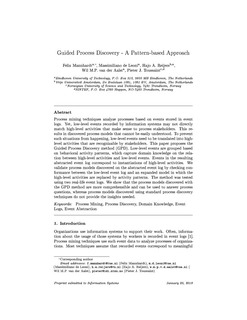| dc.contributor.author | Mannhardt, Felix | |
| dc.contributor.author | de Leoni, Massimiliano | |
| dc.contributor.author | Reijers, Hajo A. | |
| dc.contributor.author | van der Aalst, Wil M.P. | |
| dc.contributor.author | Toussaint, Pieter Jelle | |
| dc.date.accessioned | 2019-06-12T06:06:02Z | |
| dc.date.available | 2019-06-12T06:06:02Z | |
| dc.date.created | 2018-10-09T22:40:52Z | |
| dc.date.issued | 2018 | |
| dc.identifier.citation | Information Systems. 2018, 76 1-18. | nb_NO |
| dc.identifier.issn | 0306-4379 | |
| dc.identifier.uri | http://hdl.handle.net/11250/2600532 | |
| dc.description.abstract | Process mining techniques analyze processes based on events stored in event logs. Yet, low-level events recorded by information systems may not directly match high-level activities that make sense to process stakeholders. This results in discovered process models that cannot be easily understood. To prevent such situations from happening, low-level events need to be translated into high-level activities that are recognizable by stakeholders. This paper proposes the Guided Process Discovery method (GPD). Low-level events are grouped based on behavioral activity patterns, which capture domain knowledge on the relation between high-level activities and low-level events. Events in the resulting abstracted event log correspond to instantiations of high-level activities. We validate process models discovered on the abstracted event log by checking conformance between the low-level event log and an expanded model in which the high-level activities are replaced by activity patterns. The method was tested using two real-life event logs. We show that the process models discovered with the GPD method are more comprehensible and can be used to answer process questions, whereas process models discovered using standard process discovery techniques do not provide the insights needed. | nb_NO |
| dc.language.iso | eng | nb_NO |
| dc.publisher | Elsevier | nb_NO |
| dc.rights | Attribution-NonCommercial-NoDerivatives 4.0 Internasjonal | * |
| dc.rights.uri | http://creativecommons.org/licenses/by-nc-nd/4.0/deed.no | * |
| dc.title | Guided Process Discovery - A pattern-based approach | nb_NO |
| dc.type | Journal article | nb_NO |
| dc.type | Peer reviewed | nb_NO |
| dc.description.version | acceptedVersion | nb_NO |
| dc.source.pagenumber | 1-18 | nb_NO |
| dc.source.volume | 76 | nb_NO |
| dc.source.journal | Information Systems | nb_NO |
| dc.identifier.doi | 10.1016/j.is.2018.01.009 | |
| dc.identifier.cristin | 1619195 | |
| dc.description.localcode | © 2018. This is the authors’ accepted and refereed manuscript to the article. Locked until 21 March 2020 due to copyright restrictions. This manuscript version is made available under the CC-BY-NC-ND 4.0 license http://creativecommons.org/licenses/by-nc-nd/4.0/ | nb_NO |
| cristin.unitcode | 194,63,10,0 | |
| cristin.unitname | Institutt for datateknologi og informatikk | |
| cristin.ispublished | true | |
| cristin.fulltext | original | |
| cristin.qualitycode | 2 | |

